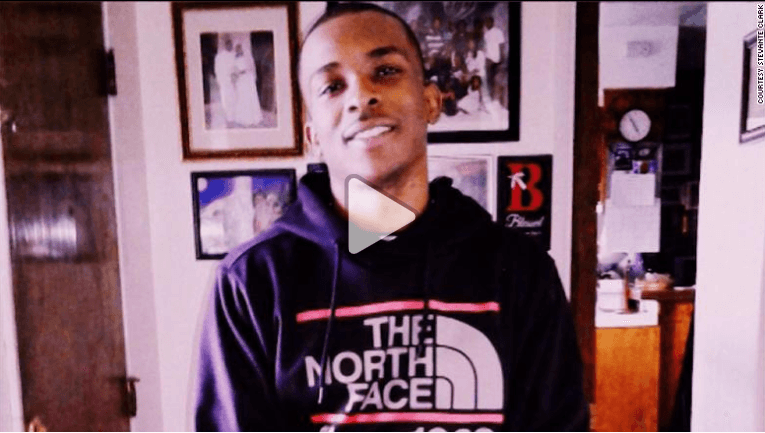Editor’s Note: Luther O. Tyus is a graduate research assistant in the Brown School at Washington University in St. Louis, as well as an eight-year veteran of the St. Louis Police Department and a certified Peace Officer Standards and Training police instructor. The views expressed in this commentary are his own.
The first time I almost killed a man was two years after graduating from the police academy. I was working at a local nightclub when a brawl erupted. Wading through the sucker punches and small skirmishes, I saw a man walk to his car, retrieve a long brown item and approach the nightclub entrance. My heart raced. I turned toward the subject and unsnapped my holster.
As a young African-American officer, I understood the threat of losing one’s life in the line of duty. But today, as an eight-year veteran of the St. Louis Police Department who studies ways to improve officer training, I also understand — as the recent shooting of Stephon Clark reminds us — that police shoot black Americans at higher rates than they do white Americans.
To understand why officers choose to kill, we must first examine how the brain works under deadly duress — a social science known as “killology.” From an evolutionary perspective, killing represents an acute stress response — part of a spectrum that ranges from fight to flight to freezing, posturing and submission. To power this response, the body releases epinephrine, a hormone that raises glucose levels in the blood. Energy soars, strength is enhanced and reflexes quicken.
But as all that energy pumps through the muscles, our frontal lobes — which house the rational, conscious brain — shut down. The “old brain” takes control. The old brain includes the brain stem, medulla, pons, reticular formation, thalamus, cerebellum, amygdala, hypothalamus and hippocampus. Together, these areas regulate basic functions such as breathing, moving, resting, feeding, emotions and memory. The old brain has one main goal: survival.
Letting the old brain take charge can lead to another phenomenon known as “change blindness.” First coined by Dr. Bill Lewinski, founder of the Force Science Institute, a research organization that studies use-of-force situations, change blindness is frequently taught in local police departments. It refers to important elements of a scene or situation that, viewed under duress, can easily go unnoticed.
Unsnapping my holster, I experienced change blindness. I saw what appeared to be a long-barreled handgun in the man’s left hand. I pulled my weapon and shouted, “Drop the gun.” He didn’t see me, but he did hear me. He dropped the weapon. The “gun” was actually a hammer.
Now consider former Tulsa officer Betty Shelby. On September 16, 2016, Shelby responded to a call. Terence Crutcher’s car was parked in the middle of a road. Police video from the incident, widely viewed on YouTube, captured what happened next.
Crutcher walks away from Shelby, toward his SUV with his hands up. Another officer tases him, causing him to fall to the ground. Shelby then shoots Crutcher in the back, killing him.
Why? Before the incident, Shelby received a “mental anchor” (a common bias that all humans rely on when processing initial information) in the form of a radio description. A police helicopter pilot had described Crutcher as a “bad dude.”
When I shouted at the man outside the nightclub, ordering him to lower his weapon, I displayed an act of aggression — posturing — rather than one of violence. Based on what has been reported, I would conclude that in killing Crutcher, Shelby displayed an act of violence rather than one of aggression.
Fighting is an act of violence; killing is an act of violence. But posturing resides on the opposite end of the spectrum. Rattlesnakes, piranhas and other small but fierce animals posture while in physical contest with animals of the same species.
Humans posture, too, when specific factors, such as culture, social class, religion or nationality, are shared. Though still in its early stages, my own research suggests that minority officers are more likely to posture, rather than to simply kill, minority subjects.
Shelby was later acquitted of manslaughter. But to a certain extent, her decision to kill Crutcher was made before the incident. Shelby was influenced by factors hidden within her subconscious. Crutcher’s bulky size, dark complexion and ethnicity — along with the “bad dude” mental anchor — likely all played critical, if subliminal, roles in his untimely death.
Details of Clark’s killing are still emerging, but, according to CNN, the officers involved say they mistook his cellphone for a weapon. Too often, police training neglects to identify the mental primers that affect policing decisions during life and death situations. But learning to identify and deconstruct the brain’s negative feedback loops can help combat use of force mistakes.To save lives, especially in urban, minority-rich environments, we must train officers to understand how the brain responds in conditions of deadly duress.
Read the full article featured on CNN here.
